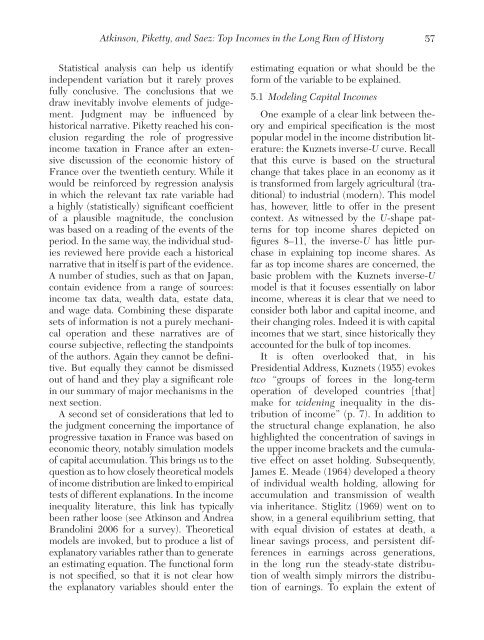56Journal <strong>of</strong> Economic Literature, Vol. XLIX (March 2011)a partial restoration <strong>of</strong> capital <strong>in</strong>comes s<strong>in</strong>ce1979.5. Seek<strong>in</strong>g Possible Explanations:Theoretical Models <strong>and</strong>Empirical SpecificationsFrom <strong>the</strong> data on <strong>the</strong> changes <strong>in</strong> <strong>the</strong> upperpart <strong>of</strong> <strong>the</strong> <strong>in</strong>come distribution assembled for<strong>the</strong>se twenty-two countries, certa<strong>in</strong> possibleexplanations st<strong>and</strong> out. We have drawn attentionto <strong>the</strong> falls <strong>in</strong> top <strong>in</strong>come shares <strong>in</strong> countriesfight<strong>in</strong>g <strong>in</strong> <strong>the</strong> First <strong>and</strong> Second WorldWars (<strong>and</strong> that some, but not all, noncombatantcountries, were less strongly hit or evensaw an <strong>in</strong>crease <strong>in</strong> top shares). Accord<strong>in</strong>g toMoriguchi <strong>and</strong> Saez (2008), “<strong>the</strong> def<strong>in</strong><strong>in</strong>gevent for <strong>the</strong> evolution <strong>of</strong> <strong>in</strong>come concentration<strong>in</strong> Japan was a historical accident, namely<strong>the</strong> Second World War” (see figure 9). Lessmomentous, but still dist<strong>in</strong>ctive, was <strong>the</strong>commodity price boom <strong>of</strong> 1950, which saw arise <strong>in</strong> top shares <strong>in</strong> Australia, New Zeal<strong>and</strong>,<strong>and</strong> S<strong>in</strong>gapore (see figures 8, 11). In <strong>the</strong>secases, a s<strong>in</strong>gle event is sufficiently large forus to be content <strong>with</strong> a s<strong>in</strong>gle variable analysis.Moreover, <strong>the</strong>re is unlikely to be reversecausality, <strong>with</strong> <strong>the</strong> fall or rise <strong>in</strong> shares caus<strong>in</strong>g<strong>the</strong> wars or <strong>the</strong> commodity boom.In general, however, explanations arelikely to be multivariate <strong>and</strong> we are confronted<strong>with</strong> <strong>the</strong> task <strong>of</strong> seek<strong>in</strong>g to separatedifferent <strong>in</strong>fluences. Piketty (2007) suggestedthat <strong>the</strong> database could be exploitedas a cross-country panel, <strong>and</strong> this approachhas been adopted by Ro<strong>in</strong>e, Jonas Vlachos,<strong>and</strong> Waldenström (2009) <strong>and</strong> Atk<strong>in</strong>son <strong>and</strong>Leigh (2007b). The former authors f<strong>in</strong>d,for example, that growth <strong>in</strong> GDP per headis associated <strong>with</strong> <strong>in</strong>creases <strong>in</strong> top <strong>in</strong>comeshares <strong>and</strong> that f<strong>in</strong>ancial developmentis pro-rich <strong>in</strong> <strong>the</strong> early stages <strong>of</strong> a country’sdevelopment. F<strong>in</strong>ancial developmentcould well <strong>in</strong>duce activity to shift from <strong>the</strong><strong>in</strong>formal to <strong>the</strong> formal economy, reveal<strong>in</strong>g<strong>in</strong>comes at least for <strong>the</strong> high skilled ra<strong>the</strong>rthan <strong>in</strong>duc<strong>in</strong>g a jump <strong>in</strong> real <strong>in</strong>comes at <strong>the</strong>top <strong>of</strong> <strong>the</strong> distribution.Multivariate statistical analysis may helpus disentangle some <strong>of</strong> <strong>the</strong> factors at work. Inparticular, a number <strong>of</strong> <strong>the</strong> studies, follow<strong>in</strong>gPiketty (2001, 2003), highlight <strong>the</strong> role<strong>of</strong> progressive <strong>in</strong>come taxation. But how canwe be sure that <strong>the</strong>re is a causal path fromprogressive taxation to reduced top <strong>in</strong>comeshares? In <strong>the</strong> United K<strong>in</strong>gdom, high toprates <strong>of</strong> <strong>in</strong>come tax were first <strong>in</strong>troduceddur<strong>in</strong>g <strong>the</strong> First World War. Could <strong>the</strong>se taxrates, <strong>and</strong> <strong>the</strong> reduction <strong>in</strong> top shares, not beseen as both result<strong>in</strong>g from third factors associated<strong>with</strong> <strong>the</strong> war <strong>and</strong> its aftermath, such as<strong>the</strong> loss <strong>of</strong> overseas <strong>in</strong>come? Statistical analysisseeks to separate out <strong>the</strong> <strong>in</strong>dependentvariation <strong>in</strong> different variables. For example,<strong>the</strong> United K<strong>in</strong>gdom was a combatant <strong>in</strong> <strong>the</strong>First World War but not <strong>the</strong> Ne<strong>the</strong>rl<strong>and</strong>s. Itmay <strong>the</strong>refore be <strong>in</strong>formative to compare <strong>the</strong>two countries, both <strong>of</strong> which had progressive<strong>in</strong>come taxes. At <strong>the</strong> same time, <strong>the</strong>reare possible third factors. Both <strong>the</strong> UnitedK<strong>in</strong>gdom <strong>and</strong> <strong>the</strong> Ne<strong>the</strong>rl<strong>and</strong>s faced similarglobal economic conditions that may have<strong>in</strong>dependently affected top shares. In <strong>the</strong>same way, policies o<strong>the</strong>r than progressivetaxation may matter. First World War tax<strong>in</strong>creases <strong>in</strong> <strong>the</strong> United K<strong>in</strong>gdom had been<strong>in</strong>itiated by Liberal governments which pursuedo<strong>the</strong>r redistributive policies apart from<strong>in</strong>come taxation such as measures to preventpr<strong>of</strong>iteer<strong>in</strong>g <strong>in</strong> <strong>the</strong> First World War. In<strong>the</strong> recent period, <strong>the</strong> tax cuts <strong>of</strong> <strong>the</strong> 1980s<strong>in</strong> <strong>the</strong> United States <strong>and</strong> United K<strong>in</strong>gdomtook place under Reagan <strong>and</strong> Thatcher whoalso pushed for liberalization <strong>of</strong> capital markets<strong>and</strong> privatization, both <strong>of</strong> which couldhave <strong>in</strong>creased top <strong>in</strong>come shares. Thereis also <strong>the</strong> possibility <strong>of</strong> reverse causality.The <strong>in</strong>creases <strong>in</strong> top <strong>in</strong>comes as a result <strong>of</strong>changed executive remuneration policiesmay have <strong>in</strong>creased political pressure forcutt<strong>in</strong>g top taxes. We need <strong>the</strong>refore a simultaneous,as well as multivariate, model.
Atk<strong>in</strong>son, Piketty, <strong>and</strong> Saez: <strong>Top</strong> <strong>Incomes</strong> <strong>in</strong> <strong>the</strong> <strong>Long</strong> <strong>Run</strong> <strong>of</strong> History57Statistical analysis can help us identify<strong>in</strong>dependent variation but it rarely provesfully conclusive. The conclusions that wedraw <strong>in</strong>evitably <strong>in</strong>volve elements <strong>of</strong> judgement.Judgment may be <strong>in</strong>fluenced byhistorical narrative. Piketty reached his conclusionregard<strong>in</strong>g <strong>the</strong> role <strong>of</strong> progressive<strong>in</strong>come taxation <strong>in</strong> France after an extensivediscussion <strong>of</strong> <strong>the</strong> economic history <strong>of</strong>France over <strong>the</strong> twentieth century. While itwould be re<strong>in</strong>forced by regression analysis<strong>in</strong> which <strong>the</strong> relevant tax rate variable hada highly (statistically) significant coefficient<strong>of</strong> a plausible magnitude, <strong>the</strong> conclusionwas based on a read<strong>in</strong>g <strong>of</strong> <strong>the</strong> events <strong>of</strong> <strong>the</strong>period. In <strong>the</strong> same way, <strong>the</strong> <strong>in</strong>dividual studiesreviewed here provide each a historicalnarrative that <strong>in</strong> itself is part <strong>of</strong> <strong>the</strong> evidence.A number <strong>of</strong> studies, such as that on Japan,conta<strong>in</strong> evidence from a range <strong>of</strong> sources:<strong>in</strong>come tax data, wealth data, estate data,<strong>and</strong> wage data. Comb<strong>in</strong><strong>in</strong>g <strong>the</strong>se disparatesets <strong>of</strong> <strong>in</strong>formation is not a purely mechanicaloperation <strong>and</strong> <strong>the</strong>se narratives are <strong>of</strong>course subjective, reflect<strong>in</strong>g <strong>the</strong> st<strong>and</strong>po<strong>in</strong>ts<strong>of</strong> <strong>the</strong> authors. Aga<strong>in</strong> <strong>the</strong>y cannot be def<strong>in</strong>itive.But equally <strong>the</strong>y cannot be dismissedout <strong>of</strong> h<strong>and</strong> <strong>and</strong> <strong>the</strong>y play a significant role<strong>in</strong> our summary <strong>of</strong> major mechanisms <strong>in</strong> <strong>the</strong>next section.A second set <strong>of</strong> considerations that led to<strong>the</strong> judgment concern<strong>in</strong>g <strong>the</strong> importance <strong>of</strong>progressive taxation <strong>in</strong> France was based oneconomic <strong>the</strong>ory, notably simulation models<strong>of</strong> capital accumulation. This br<strong>in</strong>gs us to <strong>the</strong>question as to how closely <strong>the</strong>oretical models<strong>of</strong> <strong>in</strong>come distribution are l<strong>in</strong>ked to empiricaltests <strong>of</strong> different explanations. In <strong>the</strong> <strong>in</strong>come<strong>in</strong>equality literature, this l<strong>in</strong>k has typicallybeen ra<strong>the</strong>r loose (see Atk<strong>in</strong>son <strong>and</strong> AndreaBr<strong>and</strong>ol<strong>in</strong>i 2006 for a survey). Theoreticalmodels are <strong>in</strong>voked, but to produce a list <strong>of</strong>explanatory variables ra<strong>the</strong>r than to generatean estimat<strong>in</strong>g equation. The functional formis not specified, so that it is not clear how<strong>the</strong> explanatory variables should enter <strong>the</strong>estimat<strong>in</strong>g equation or what should be <strong>the</strong>form <strong>of</strong> <strong>the</strong> variable to be expla<strong>in</strong>ed.5.1 Model<strong>in</strong>g Capital <strong>Incomes</strong>One example <strong>of</strong> a clear l<strong>in</strong>k between <strong>the</strong>ory<strong>and</strong> empirical specification is <strong>the</strong> mostpopular model <strong>in</strong> <strong>the</strong> <strong>in</strong>come distribution literature:<strong>the</strong> Kuznets <strong>in</strong>verse-U curve. Recallthat this curve is based on <strong>the</strong> structuralchange that takes place <strong>in</strong> an economy as itis transformed from largely agricultural (traditional)to <strong>in</strong>dustrial (modern). This modelhas, however, little to <strong>of</strong>fer <strong>in</strong> <strong>the</strong> presentcontext. As witnessed by <strong>the</strong> U-shape patternsfor top <strong>in</strong>come shares depicted onfigures 8–11, <strong>the</strong> <strong>in</strong>verse-U has little purchase<strong>in</strong> expla<strong>in</strong><strong>in</strong>g top <strong>in</strong>come shares. Asfar as top <strong>in</strong>come shares are concerned, <strong>the</strong>basic problem <strong>with</strong> <strong>the</strong> Kuznets <strong>in</strong>verse-Umodel is that it focuses essentially on labor<strong>in</strong>come, whereas it is clear that we need toconsider both labor <strong>and</strong> capital <strong>in</strong>come, <strong>and</strong><strong>the</strong>ir chang<strong>in</strong>g roles. Indeed it is <strong>with</strong> capital<strong>in</strong>comes that we start, s<strong>in</strong>ce historically <strong>the</strong>yaccounted for <strong>the</strong> bulk <strong>of</strong> top <strong>in</strong>comes.It is <strong>of</strong>ten overlooked that, <strong>in</strong> hisPresidential Address, Kuznets (1955) evokestwo “groups <strong>of</strong> forces <strong>in</strong> <strong>the</strong> long-termoperation <strong>of</strong> developed countries [that]make for widen<strong>in</strong>g <strong>in</strong>equality <strong>in</strong> <strong>the</strong> distribution<strong>of</strong> <strong>in</strong>come” (p. 7). In addition to<strong>the</strong> structural change explanation, he alsohighlighted <strong>the</strong> concentration <strong>of</strong> sav<strong>in</strong>gs <strong>in</strong><strong>the</strong> upper <strong>in</strong>come brackets <strong>and</strong> <strong>the</strong> cumulativeeffect on asset hold<strong>in</strong>g. Subsequently,James E. Meade (1964) developed a <strong>the</strong>ory<strong>of</strong> <strong>in</strong>dividual wealth hold<strong>in</strong>g, allow<strong>in</strong>g foraccumulation <strong>and</strong> transmission <strong>of</strong> wealthvia <strong>in</strong>heritance. Stiglitz (1969) went on toshow, <strong>in</strong> a general equilibrium sett<strong>in</strong>g, that<strong>with</strong> equal division <strong>of</strong> estates at death, al<strong>in</strong>ear sav<strong>in</strong>gs process, <strong>and</strong> persistent differences<strong>in</strong> earn<strong>in</strong>gs across generations,<strong>in</strong> <strong>the</strong> long run <strong>the</strong> steady-state distribution<strong>of</strong> wealth simply mirrors <strong>the</strong> distribution<strong>of</strong> earn<strong>in</strong>gs. To expla<strong>in</strong> <strong>the</strong> extent <strong>of</strong>
- Page 5 and 6: Atkinson, Piketty, and Saez: Top In
- Page 7 and 8: Atkinson, Piketty, and Saez: Top In
- Page 9 and 10: Atkinson, Piketty, and Saez: Top In
- Page 11 and 12: Atkinson, Piketty, and Saez: Top In
- Page 13 and 14: Atkinson, Piketty, and Saez: Top In
- Page 15 and 16: Atkinson, Piketty, and Saez: Top In
- Page 17 and 18: Atkinson, Piketty, and Saez: Top In
- Page 19 and 20: Atkinson, Piketty, and Saez: Top In
- Page 21 and 22: Atkinson, Piketty, and Saez: Top In
- Page 23 and 24: Atkinson, Piketty, and Saez: Top In
- Page 25 and 26: Atkinson, Piketty, and Saez: Top In
- Page 27 and 28: Atkinson, Piketty, and Saez: Top In
- Page 29 and 30: Atkinson, Piketty, and Saez: Top In
- Page 31 and 32: Atkinson, Piketty, and Saez: Top In
- Page 33 and 34: Atkinson, Piketty, and Saez: Top In
- Page 35 and 36: Atkinson, Piketty, and Saez: Top In
- Page 37 and 38: Atkinson, Piketty, and Saez: Top In
- Page 39 and 40: Atkinson, Piketty, and Saez: Top In
- Page 41 and 42: Atkinson, Piketty, and Saez: Top In
- Page 43 and 44: Atkinson, Piketty, and Saez: Top In
- Page 45 and 46: Atkinson, Piketty, and Saez: Top In
- Page 47 and 48: Atkinson, Piketty, and Saez: Top In
- Page 49 and 50: Atkinson, Piketty, and Saez: Top In
- Page 51 and 52: Atkinson, Piketty, and Saez: Top In
- Page 53: Atkinson, Piketty, and Saez: Top In
- Page 57 and 58: Atkinson, Piketty, and Saez: Top In
- Page 59 and 60: Atkinson, Piketty, and Saez: Top In
- Page 61 and 62: Atkinson, Piketty, and Saez: Top In
- Page 63 and 64: Atkinson, Piketty, and Saez: Top In
- Page 65 and 66: Atkinson, Piketty, and Saez: Top In
- Page 67 and 68: Atkinson, Piketty, and Saez: Top In
- Page 69: Atkinson, Piketty, and Saez: Top In















